

![]()
HERDING DOGS OF EASTERN EUROPE
THE HERDING DOGS OF THE BALKANS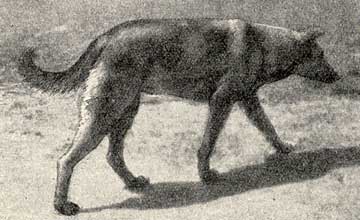
Above, an old type of Serbian sheepdog.
You can see from these old photos
that many of the Eastern European sheepdogs
were very similar to some of the Western European sheepdogs
that are being used today, particularly those from Southern Europe.
(Photo from von Stephanitz.)
The Balkan States are so called because they occupy the Balkan Peninsula in southeastern Europe. It is a mountainous area, heavily subdivided politically, culturally, and linguistically. Today, ten countries make up up the area, Slovenia, Croatia, Bosnia and Hertsegovina, Montenegro, Serbia, Kosovo, Albania, Macedonia, Bulgaria, and Greece. Croatia is unique in having its own indigenous herding dog, and we will consider it separately for this reason. Agriculture was once the major occupation of the people of the Balkan States, but this is no longer the case in many of the countries. In Slovenia, for instance, agriculture represents only 5% of the Gross Domestic Product (GDP) today. However, despite the fact that these countries do not seem to be using herding dogs today, Capt. Max von Stephanitz indicated that there were once herding dogs in this area. He said "We have now arrived in the Balkans...where for a year and a half I had the opportunity of observing the dogs closely. In these parts I never saw a large herdsman's dog similar to the Aftcharka [sic] or the Komondor, but only genuine shepherd dogs...." It is sad to think that these dogs may be extinct today, but that unfortunately seems to be the case.
Bosnia and Herzegovina
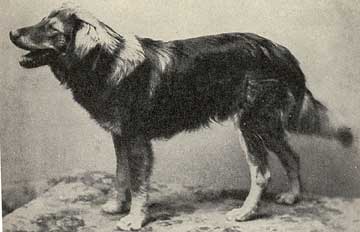 Left, an old type of Bosnian herdsman's dog. (Photo from von Stephanitz.)
Left, an old type of Bosnian herdsman's dog. (Photo from von Stephanitz.)
Bosnia and Herzegovina has more than 50% of its land still in agriculture and more than 50% of that is given to pasture. Sheep are widely distributed but mostly in hill and mountain areas, and it is still common practice to move sheep to the higher areas in summer, and back to the plains and lower hills in winter. It appears that dogs are needed, but are they actually used, and if they are, which ones? I have been unable to find out. However, there was once a Bosnian Herdsmans Dog. The photo from von Stephanitz shows a blue merle collie-type dog.
Albania
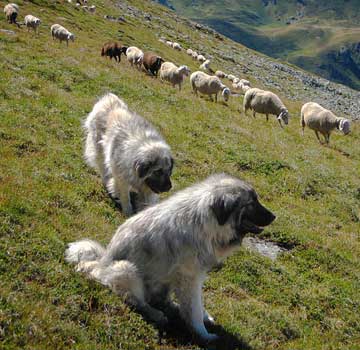 Right, two Shar Mountain Dogs. We are mentioning them with Albania, but the photo was taken in Kosovo
Right, two Shar Mountain Dogs. We are mentioning them with Albania, but the photo was taken in Kosovo
Almost 50% of the population of Albania is employed in agriculture. Albania has four indigenous breeds of sheep and almost two million sheep. Transhumance is still common practice in the high mountain regions of Albania. While it seems to have no indigenous herding dog, the Sarplaninac, a large molosser-type guardian breed, is claimed for Albania, Kosovo, Serbia and northwest Macedonia. This dog, which originally was known as the Illyrian Shepherd (for the ancient Balkan Kingdom of Illyria, of which Albania was a part) is now being promoted as the Shar or Shari Dog in Albania, and is said to be both a guardian and herding dog. However, Carla Cruz, a biologist and animal scientist, says that livestock guardian breeds require "a set of innate behaviors incompatible with being a good herding dog."
Serbia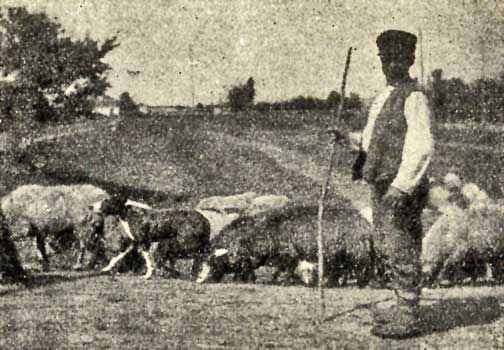
Above, a Serbian shepherd with his flock and small black-and-white sheepdog. (Photo from von Stephanitz.)
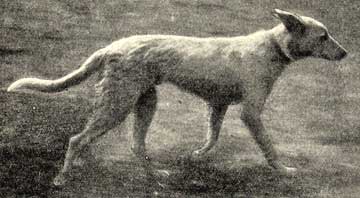
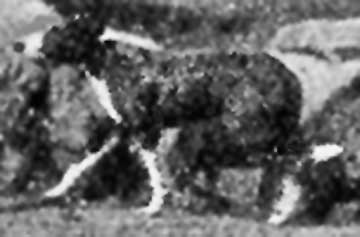 Left, another old type of Serbian sheepdog, this one light colored. (Photo from von Stephanitz.) and right, a detail from the photo above, shows the black and white dog a bit better.
Left, another old type of Serbian sheepdog, this one light colored. (Photo from von Stephanitz.) and right, a detail from the photo above, shows the black and white dog a bit better.
Serbia, a somewhat larger country, has both mountains and plains, which Zoran Njegovan and Olgica Boskovic call "very good natural conditions for the production of wool and meat from sheep and goats. Sheep are mostly produced on natural pastures." However, only 12.7% of Serbia's GDP is from agriculture altogether, although agriculture remains the chief economic activity in rural areas. Ninety percent of the sheep in Serbia are concentrated in small farms. Do they use dogs? There was once a Serbian Shepherd Dog, and according to von Stephanitz, "In Northern Serbia they are mostly of the smaller size, from 20-22 inches, but towards the South they attained a good average size, up to 24 inches and over." Let's not forget that von Stephanitz is the father of the modern GSD, for whom big was better. He goes on to say "In North Serbia I never saw any dogs with the smaller sheep flocks that were only driven and guarded by the shepherd and his boys...Farther South, however, I often saw dogs accompanying the sheep...The very name given to this dog is sufficient proof that the Serb is well acquainted with the possibilities of the shepherd dog, for he distinguishes between the 'ovcsarski pseto' (shepherd dog)...and the pastturski pseto' (herdsman's dog) which were used in connection with the cattle." These dogs are apparently extinct today.
Bulgaria
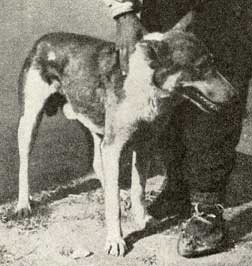 Left an old type of Bulgarian herdsman's dog. (Photo from von Stephanitz.)
Left an old type of Bulgarian herdsman's dog. (Photo from von Stephanitz.)
In Bulgaria, one of the larger Balkan countries, pastures are scarce, wool prices are down, and farmers are reluctant to raise sheep at all. On the occasions where Border Collies and even Kelpies have been imported, bemoans Nicholay Atanassov, a cynologist and veterinarian in Bulgaria, no one has worked with them and the bloodlines have been mixed and degenerated. Von Stephanitz mentions Bulgaria briefly, saying "The Bulgarians...only have the name 'tschobansko kutsche' for both shepherd's dog and herdsman's dog...[however in] Bulgaria, where the main livestock is sheep, dogs work the sheep as well as the cattle [and] all the Bulgarian soldier-shepherds who pastured the Army herds, have dogs with them, in some cases quite magnificent specimens who, I am sorry to say, were only too clever in evading the wiles of the camera fiend."
Montenegro
Montenegro is a small mountainous country on the Adriatic Sea, making it ideal for the service industry (tourism). Only 10% of its GDP is in Agriculture. Sheep are kept mainly in northern Montenegro. Sheep are housed in winter, grazed on meadowland in Spring and Autumn, and in summer moved up the the mountains to the katun, a temporary settlement for shepherds similar to the sheilings in Scotland. Goats are also grazed on higher, poorer pasture. These are situations that should require herding dogs, but none are mentioned in the literature.
Greece and Macedonia
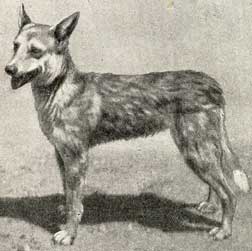 Right, an old type of Macedonian shepherds dog. This dog is very similar to the types we see in other parts of Europe. (Photo from von Stephanitz.)
Right, an old type of Macedonian shepherds dog. This dog is very similar to the types we see in other parts of Europe. (Photo from von Stephanitz.)
Although agriculture in Greece makes up only 3.6% of its GDP, there are more than 500,000 farmers making up 12% of the labor force, and sheep and goat production is very important. However, most sheep farming is done in the less productive mountainous areas, and sheep farming has steadily declined since the 1980s. Eighty-four percent of sheep production happens on communal pastures, and in orchards and fields after harvesting. The flocks are accompanied by an itinerant shepherd. Some small percentage of sheep flocks are still nomadic, spending six months grazing the mountains, and then trucked back to the foothills for the winter. These flocks are accompanied by farming families who have no permanent residences. The production of milk products is paramount. Von Stephanitz only mentions a Greek shepherd dog, saying he was told they were similar to the dogs of Bulgaria and Macedonia. He has several photos of Macedonian dogs, and says "In Southern Macedonia I never saw dogs with small livestock, but very often with cattle and with Asiatic buffaloes." These dogs resemble the Italian Cane Lupino.
Copyright © 2014 by Carole L. Presberg
Resources:
Alibegovic-Grbic, Senija. "Country Pasture/Forage Resource Profile, Bosnia and Herzegovina", 2009.
Animal Research Institute: "Sheep and goat production in Greece", National Agricultural Foundation (N.AG.RE.F.) ca 2003.
Atanassov, Nicholay. From private correspondence.
Cruz, Carla. A biologist, researcher, and kennel owner, from private correspondence.
Dubljevic, Radisav. "Country Pasture/Forage Resource Profiles", 2009 (http://www.fao.org/ag/AGP/AGPC/doc/Counprof/montenegro/montenegro.htm#4ruminant).
Habe, F. and J. Polgacar, M. Kovac, and D. Kompan. "Breeding Strategies for Cattle, Pigs and Sheep in Slovenia", Regional Office for Europe, exact date unknown but after 1997
Mavromati, J., et al. "The Production Systems and Economics of Sheep Husbandry in Southern Albania", Conference on Biotechnology in Animal Husbandry, 2011.
Njegovan, Zoran and Olgica Boskovic. "Agriculture of Serbia and Montenegro", Agora Without Frontiers, 2006.
Petrovic, M.P. et al. "Opportunities and Challenges for Sustainable Sheep Production in Serbia", Biotechnology in Animal Husbandry, 2011.
"Promotion of the Ancient Shari Dog Breed Among Albanian Shepherds", Small Grants Program (http://sgp.undp.org/index.php?option=com_sgpprojects&view=projectdetail&id=14073&Itemid=205#.UOSDbxg5sfI).
Von Stephanitz, Capt. Max. The German Shepherd Dog, originally published ca. 1918 in German; 8th edition published in German in 1932; English edition of 8th edition published 1947, published by Verein für deutsche Schäferhunde.
Wikipedia: "Albania" (en.wikipedia.org/wiki/Albania).
Wikipedia: "The Balkans" (en.wikipedia.org/wiki/The_Balkans).
Wikipedia: "Bosnia and Herzegovina" (en.wikipedia.org/wiki/Bosnia_and_Herzegovina).
Wikipedia: "Bulgaria" (en.wikipedia.org/wiki/Bulgaria).
Wikipedia: "Greece" (en.wikipedia.org/wiki/Greece).
Wikipedia: "Montenegro" (en.wikipedia.org/wiki/Montenegro).
Wikipedia: "Republic of Macedonia" (en.wikipedia.org/wiki/Republic_of_Macedonia).
Wikipedia: "Serbia" (en.wikipedia.org/wiki/Serbia).
Return to
![]()
BORDER COLLIE COUSINS
THE OTHER WEB PAGES WE MAINTAIN
These web pages are copyright ©2013
and maintained by webmeistress Carole Presberg
with technical help from webwizard David Presberg
ALL RIGHTS RESERVED
If you are interested in using ANY material on this website, you MUST first ask for permission.